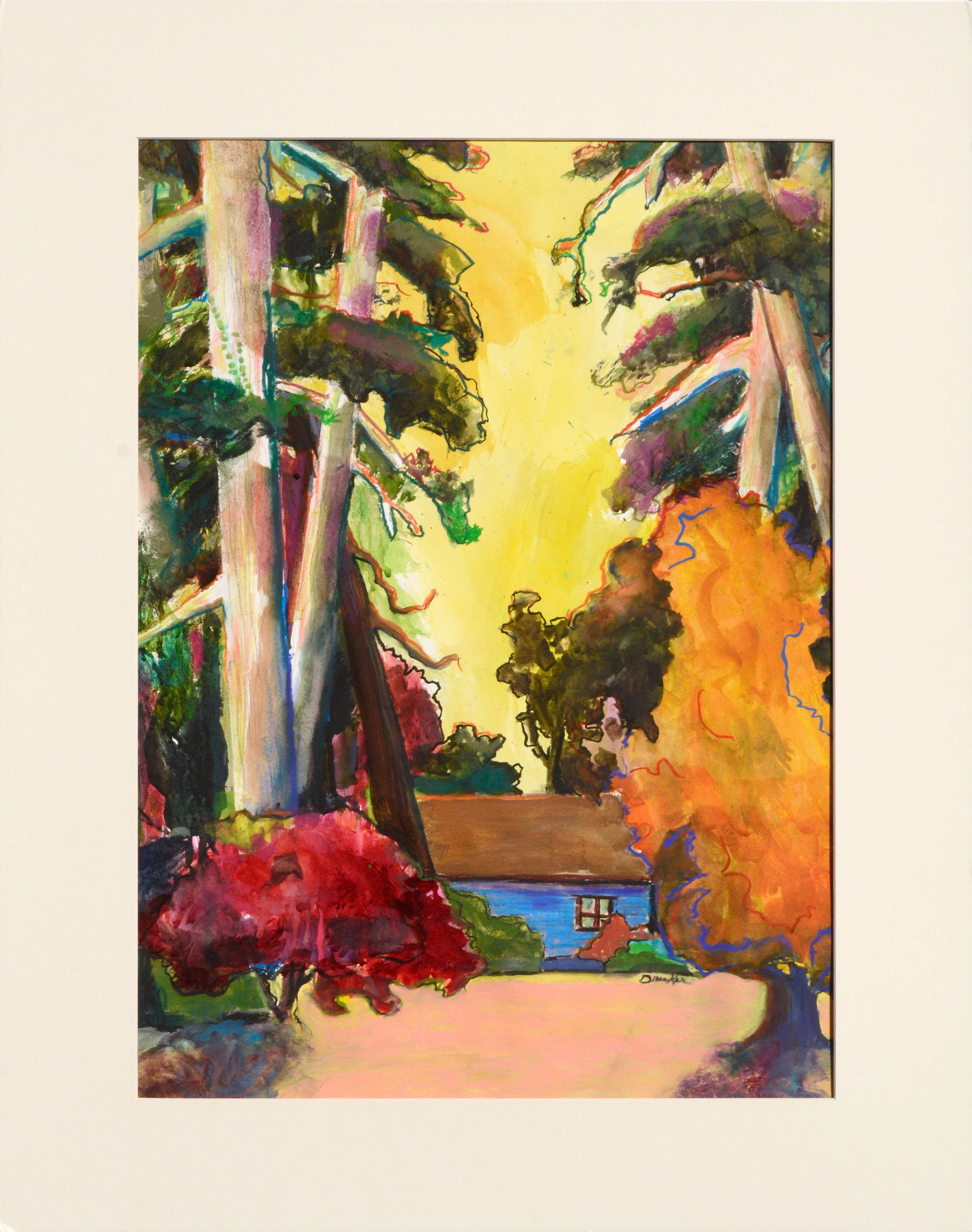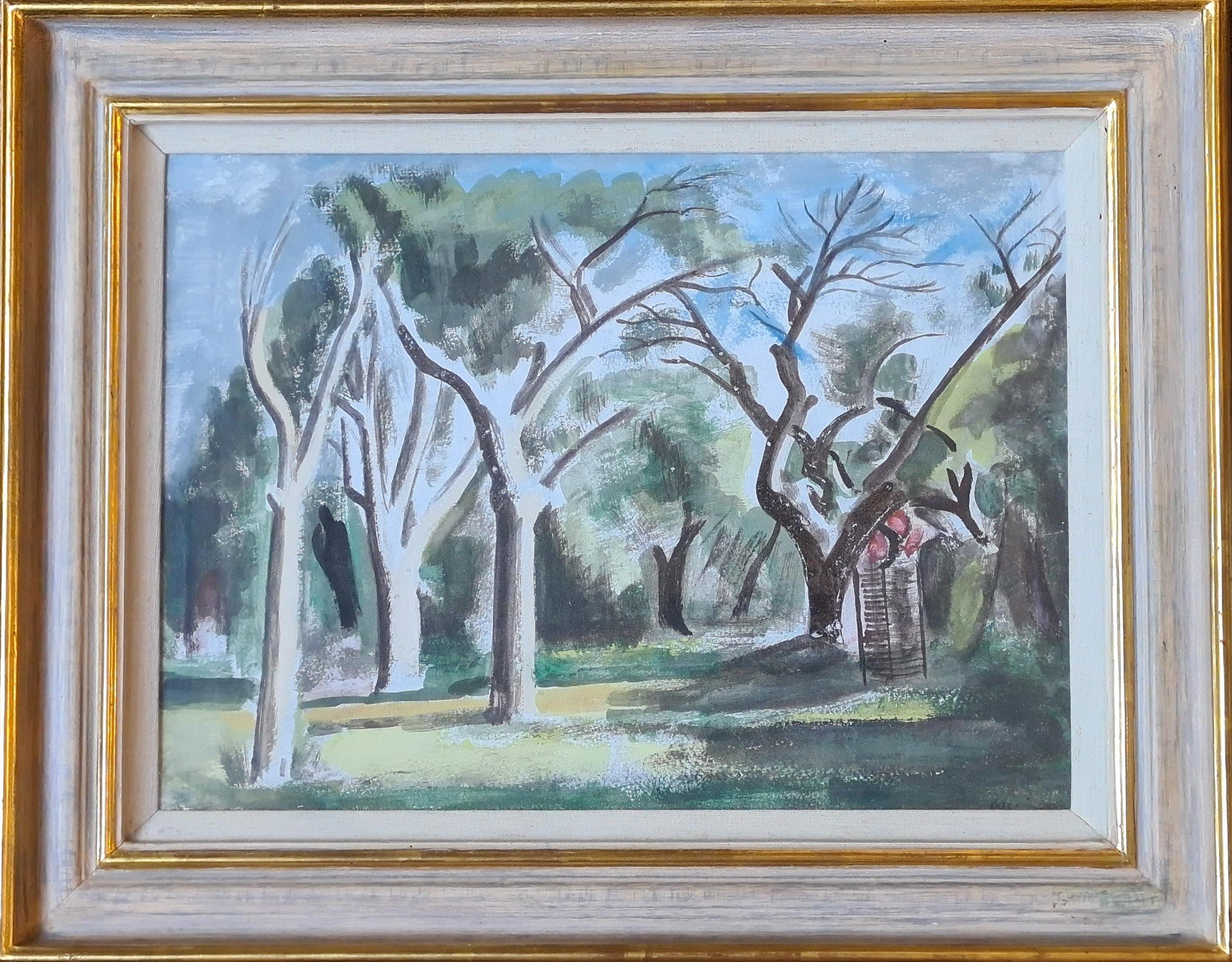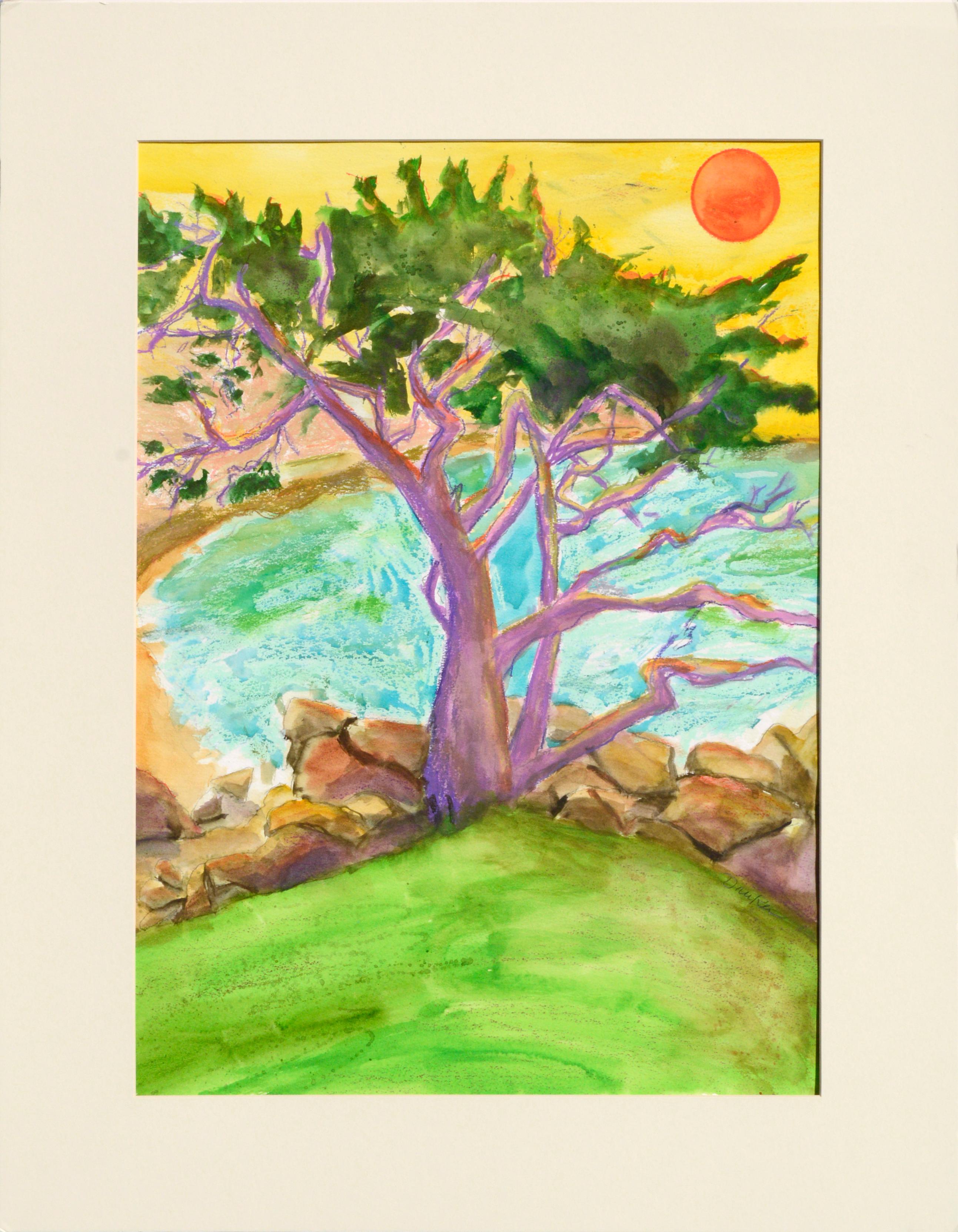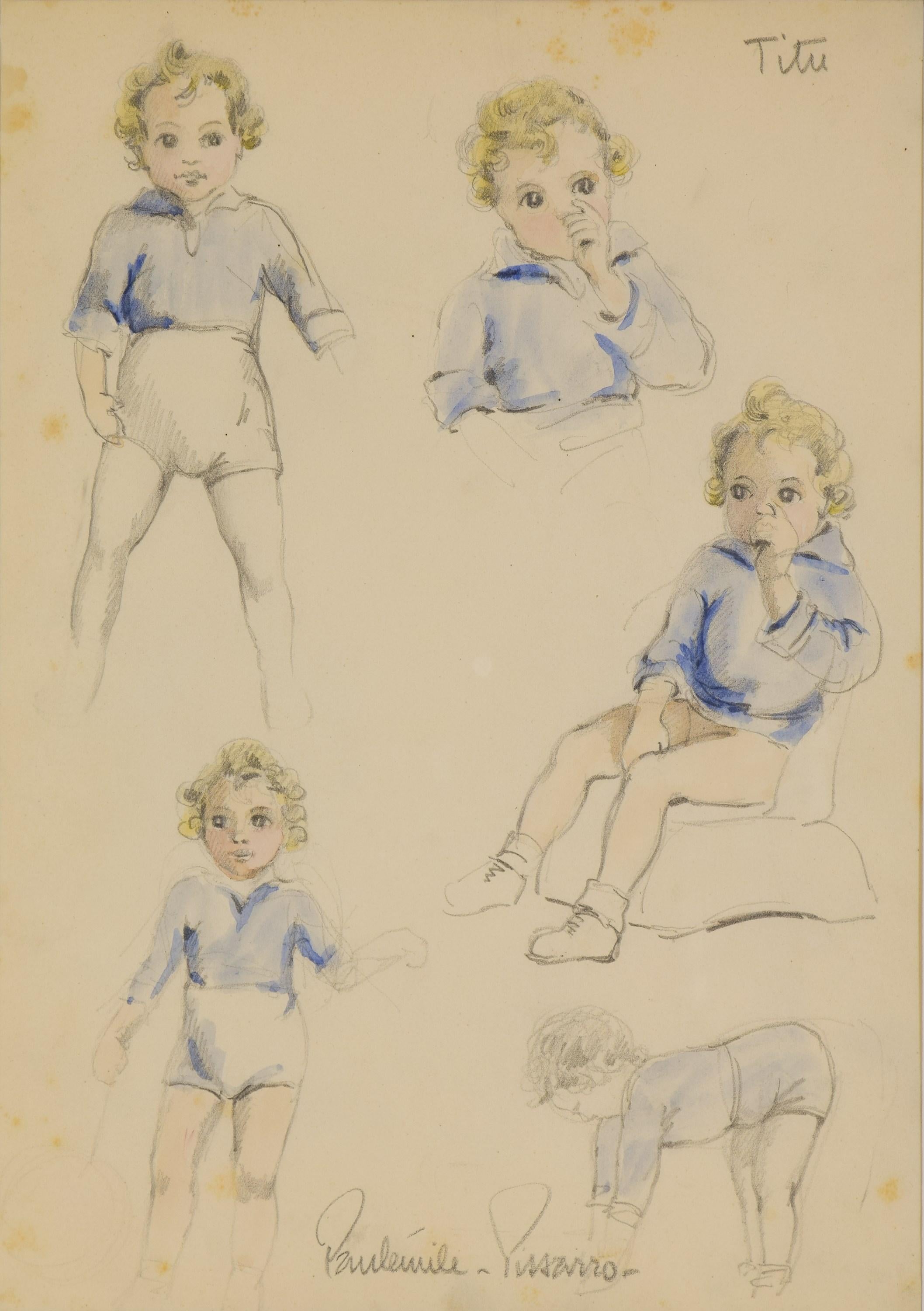Items Similar to L'Église de Morgny-Eure by Paulémile Pissarro, 1927
Want more images or videos?
Request additional images or videos from the seller
1 of 8
Paulémile PissarroL'Église de Morgny-Eure by Paulémile Pissarro, 19271927
1927
About the Item
L'Église de Morgny-Eure by Paulémile Pissarro (1884 - 1972)
Watercolour and black crayon on paper
31.5 x 43.5 cm (12 ³/₈ x 17 ¹/₈ inches)
Signed lower right, Paulémile and dated, Morgny-Eure 1927
Provenance
Private Collection, France
This work is accompanied by a certificate of authenticity by Lélia Pissarro.
Artist biography
Paulémile Pissarro, Camille Pissarro’s youngest son, was born in Éragny in 1884 where he was brought up within the creatively fertile environment of his family home and, encouraged by his father, began drawing at an early age. Paulémile’s godfather was Claude Monet, who became his teacher and legal guardian after Camille’s death in 1903.
In 1905 Paulémile exhibited at the Salon des Indépendants for the first time. Although his father had supported Paulémile’s desire to be an artist, his mother was eager for him to learn a more practical trade. Therefore in 1908 he put aside his artistic pursuits to work as an automobile mechanic and test-driver, then later as a lace and textile designer, allowing him only a limited time to paint. Paulémile only fully dedicated himself to painting following a letter from his brother Lucien in London, who wrote to invite him to take part in an exhibition held in London. Subsequent to the successful sale of a number of watercolours he had sent over, the young artist became inspired to leave the textile factory and pursue a career in art.
By the 1920s Paulémile had become an established Post-Impressionist artist in his own right, spending the summer months escaping from Paris on painting trips with fellow artists Kees Van Dongen, Raoul Dufy, Maurice de Vlaminck and André Dunoyer de Segonzac. In 1922 Paulémile purchased a house in Lyons-la-Forêt, a small village within the region of his hometown of Éragny and Giverny, where he moved in with his first wife Berthe Bennaiche. During this time, he developed a form of Cubism inspired by Paul Cézanne whom he dearly admired, creating some wonderful paintings of the river Eure and its surrounding villages. There he formed a close friendship with his neighbour, the famous Art Deco designer Émile-Jacques Ruhlmann, who designed a stunning Art Deco studio for Paulémile adjacent to his house.
In 1930 he visited and fell in love with the Swiss Normandy area in the Calvados region, in particular the River Orne which runs through the valley adjacent to the villages of Clécy and St. Remy. The combination of rolling hills, bold meadows and the calm river weaving its way through the landscape offered Paulémile a new burst of inspiration. With his second wife Yvonne Beaupel, Paulémile eventually moved to Clécy in 1935, where he would remain for the rest of his life. Of their three children, both H. Claude and Yvon also became artists.
With his house backing on to the river Orne, Paulémile developed a new way of working using a boat as a floating studio, where he spent countless days painting the calm waters from between the riverbanks. Here the influence of his godfather Claude Monet became apparent, particularly in Paulémile’s depiction of water, which was revolutionised by the Impressionist icon. He also applied Monet’s lessons in horticulture to the creation of an abundant garden, offering him many more motifs for his new paintings. Alongside these river landscapes, he also painted the neighbouring hay fields, various snow scenes, some interiors and still lives. The most ambitious work in his oeuvre was a fresco painted on all four walls of his own dining room, depicting the adjacent river in which he includes family members, neighbours and friends.
In 1967 Paulémile had his first one-man show in the United States at Wally Findlay Galleries in New York. This led to widespread recognition and a degree of professional success that few Pissarro artists knew during their lifetime. Since his death in 1972, Paulémile remains one of the best known of Camille’s sons.
- Creator:Paulémile Pissarro (1884 - 1972, French)
- Creation Year:1927
- Dimensions:Height: 12.41 in (31.5 cm)Width: 17.13 in (43.5 cm)
- Medium:
- Movement & Style:
- Period:
- Condition:
- Gallery Location:London, GB
- Reference Number:1stDibs: LU261213961062
About the Seller
5.0
Recognized Seller
These prestigious sellers are industry leaders and represent the highest echelon for item quality and design.
Gold Seller
These expertly vetted sellers are highly rated and consistently exceed customer expectations.
Established in 1964
1stDibs seller since 2015
95 sales on 1stDibs
Typical response time: 8 hours
Associations
Society Of London Art Dealers
- ShippingRetrieving quote...Ships From: London, United Kingdom
- Return PolicyA return for this item may be initiated within 7 days of delivery.
More From This SellerView All
- Études sur Titu by Paulémile Pissarro - Study drawing, 1938Located in London, GBÉtudes sur Titu by Paulémile Pissarro (1884 - 1972) Watercolour and pencil on paper 33.5 x 23.6 cm (13 ¹/₄ x 9 ¹/₄ inches) Signed lower middle Paulémile-Pissarro- and inscribed upper...Category
1930s Post-Impressionist Landscape Drawings and Watercolors
MaterialsPaper, Watercolor, Pencil
- Paysage Normand, Port en Bessin by Ludovic-Rodo Pissarro, watercolour, 1914By Ludovic-Rodo PissarroLocated in London, GBPaysage Normand, Port en Bessin by Ludovic-Rodo Pissarro (1878-1952) Watercolour and ink on paper 23.5 x 30 cm (9 ¹/₄ x 11 ³/₄ inches) Signed and dated lower right, Ludovic Rodo 1914...Category
1910s Post-Impressionist Landscape Drawings and Watercolors
MaterialsPaper, Ink, Watercolor
- Alençon by Ludovic-Rodo Pissarro - Landscape watercolourBy Ludovic-Rodo PissarroLocated in London, GB*UK BUYERS WILL PAY AN ADDITIONAL 20% VAT ON TOP OF THE ABOVE PRICE Alençon by Ludovic-Rodo Pissarro (1878-1952) Watercolour on paper 22 x 31 cm (8 ⁵/₈ x 12 ¹/₄ inches) Signed with ...Category
Early 1900s Fauvist Figurative Drawings and Watercolors
MaterialsWatercolor, Paper
- Le Défilé Royal (Illustration for Voyage au Pays des Pommes) by Lucien PissarroBy Lucien PissarroLocated in London, GBLe Défilé Royal (Illustration for Voyage au Pays des Pommes) by Lucien Pissarro (1863-1944) Watercolour on paper 22.5 x 26 cm (8 ⅞ x 10 ¼ inches) Signed lower left with monogram This work is accompanied by a letter of authenticity from Colin Harrison, Senior Curator of European Art at the Ashmolean Museum, Oxford. Provenance Mr Ian Robertson Exhibition London, Leicester Galleries, Memorial Exhibition of Lucien Pissarro's Work, Part II, 1947, No. 60 (catalogued as La Procession) Artist biography Born on the 20th February 1863, Lucien Pissarro was the eldest son of the Impressionist painter Camille Pissarro. Coached from a young age by his father and in the frequent company of figures such as Cézanne, Gauguin and Monet, it is no surprise that Lucien chose to pursue an artistic career. While he is best known as a landscape painter, Lucien was also a printmaker, wood engraver and printer of fine books, occasionally painting still lifes and portraits of his family. Lucien first visited England in 1870 with his family when fleeing the Franco-Prussian war. It was the beginning of a great love affair with the country. He decided to move permanently to England in 1890, becoming an English citizen in 1916. Until then he had worked as a landscape painter and book illustrator in France. During this period he met and worked with painters such as Paul Signac, Georges Seurat and Vincent van Gogh. Moving simultaneously in Impressionist and Neo-Impressionist circles, Lucien exhibited Pointillist paintings with his father in the last Impressionist exhibition in 1886. In the same year he was one of the first artists to exhibit in the “Salon des Indépendants” as a Neo-Impressionist. Despite his close relationship with his father, as revealed in their correspondence, Lucien showed remarkable independence of mind in his approach to his art. While Lucien was trained by his father, the influence the artists had on one another was reciprocal. Thanks to his relationship with Seurat and Signac, Lucien encouraged Camille to experiment with Pointillism, a characteristic of the Neo-Impressionist group. Lucien’s move to England in 1890 allowed him greater freedom to pursue his interest in book illustration and printing. There Lucien and his wife Esther established the Éragny Press, named after the Normandy village where his family lived since 1884. The Éragny Press was principally notable for creating aesthetically pleasing books and paved the way for the development of European book art. Lucien’s illustrations for these books demonstrate his talent and command of colour. Nevertheless, Lucien always considered painting his primary concern, particularly landscape painting. Continuing the tradition of the Impressionists, Lucien was a plein-air painter who liked to work outdoors and study the subject directly from nature. His landscapes reveal his fascination for the effects of weather and light. The contemporary art critic Frank Rutter described Lucien as a master of colour, writing in 1922: “there is no man living who has a more profound knowledge of the science of colour, or a more discriminating eye for its observation in nature.” Rutter was also struck by Lucien’s respect for his subject, nature itself: “Each canvas is wrought with a quiet perfection that conceals its art and is eloquent of the tender emotion which the loveliness of nature inspires in the artist.” It is clear from Rutter’s praise that Lucien’s contemporaries were impressed by his combination of English and French artistic traditions. Unsurprisingly, he became associated with artistic groups that drew inspiration from the Impressionists, including the New English Art Club, with whom he exhibited in 1904, the Fitzroy Street Group in 1907 and the Camden Town Group in 1911. To his English contemporaries Lucien represented a direct link to the Impressionist Masters. His influence can be recognised in the work of British artists such as Spencer Gore, Harold Gilman...Category
19th Century Post-Impressionist Landscape Drawings and Watercolors
MaterialsWatercolor, Paper
- L'Ile des Oiseaux by Paulémile Pissarro - Landscape watercolourBy Paul Emile PissarroLocated in London, GBL'Ile des Oiseaux by Paulémile Pissarro (1884-1972) Watercolour and charcoal on paper 23 x 31 cm (9 x 12 ¹/₄ inches) Signed lower right, Paulémile Pissarro Provenance Private collec...Category
20th Century Post-Impressionist Figurative Drawings and Watercolors
MaterialsInk, Paper, Watercolor
- Paysage à Chippenfield by Ludovic-Rodo Pissarro - Landscape watercolourBy Ludovic-Rodo PissarroLocated in London, GB*UK BUYERS WILL PAY AN ADDITIONAL 20% VAT ON TOP OF THE ABOVE PRICE Paysage à Chippenfield by Ludovic-Rodo Pissarro (1878-1952) Watercolour and ink on paper 23 x 33 cm (9 x 13 inche...Category
1910s Post-Impressionist Figurative Drawings and Watercolors
MaterialsInk, Paper, Watercolor
You May Also Like
- La Baie des Anges a Nice et le Casino 1928 gouache Palm Trees, Horse & CarriageBy Raoul DufyLocated in Rancho Santa Fe, CALa Baie des Anges a Nice et le Casino is a lovely gouache on paper from 1928. The work is fully authenticated by Fanny Guillon-Laffaille and is listed in the Raoul Dufy Catalogue Rai...Category
1920s Post-Impressionist Landscape Paintings
MaterialsGouache, Archival Paper
- The Blue Cabin - Vertical LandscapeBy Karen DrukerLocated in Soquel, CABrightly colored landscape of a cabin in the woods by Karen Druker (American, 1945). Signed "Druker" in the lower right corner. Presented in a cream mat. No frame. Image size: 30"H x...Category
21st Century and Contemporary Fauvist Landscape Drawings and Watercolors
MaterialsPaper, Pastel, Watercolor
- Cookham Dean, A Post Impressionist Landscape, Homage to CezanneBy Bernard MeninskyLocated in Cotignac, FRAn English Post Impressionist gouache of trees in a landscape by noted artist Bernard Meninsky. The painting is signed bottom right and presented in a very fine custom patinated and gilt frame with cloth insert, under glass. There is an exhibition label to the back of the frame, giving the painting's location 'Cookham Dean' in Berkshire near the home of noted contemporary of Meninsky, Stanley Spencer. Provenance: The Boydell Galleries, Liverpool. A charming work when Meninsky was clearly showing the influence and his love for the paintings of Cezanne. The simplification of forms, as well as the flattening of landscape and the use of colour to give perspective. An earlier work by Meninsky but important in his artistic journey to his evolving style. Bernard Meninsky (25 July 1891–12 February 1950) was a British painter of figures and landscapes in oils, watercolour and gouache, a draughtsman and a teacher. Meninsky was born in Konotop, modern-day Ukraine, where his father was a tailor and the family were Yiddish-speaking Ukrainian Jews. They moved to Liverpool when Bernard was six weeks old. Although Meninsky left school at the age of eleven, his talent for art was demonstrated by the sale of a drawing to a local comic postcard business. While working as an errand boy during the day, he attended free classes in art in the evenings, and these enabled him to gain a place at the Liverpool School of Art. He studied there from 1906 to 1911, being financed by a succession of scholarships. He attended summer courses at the Royal College of Art, London, in August 1909 and August 1910, and in 1911 he won a scholarship to study at the Académie Julian in Paris for three months. With financial support from the Liverpool Jewish community and the Jewish Educational Aid Society (JEAS), Meninsky studied at the Slade School of Fine Art in London in 1912. His contemporaries there included David Bomberg, Isaac Rosenberg...Category
Early 20th Century Post-Impressionist Landscape Paintings
MaterialsWatercolor, Gouache, Paper
- Purple Cypress Tree - Coastal Fauvist Vertical LandscapeBy Karen DrukerLocated in Soquel, CABrightly colored Fauvist coastal landscape of a vivid purple cypress tree at the edge of the water, under a bright yellow sky and orange sun by Karen Druker (American, 1945). Signed ...Category
21st Century and Contemporary Fauvist Landscape Drawings and Watercolors
MaterialsPaper, Pastel, Watercolor, Pencil
- "Gondolas at the Dock, Venice, Italy" Louis Wolchonok, Boats in the Harbor SceneBy Louis WolchonokLocated in New York, NYLouis Wolchonok (1898 - 1973) Gondolas at the Dock, Venice, Italy, 1928 Watercolor on paper Sight 18 x 23 1/2 inches Signed and dated lower right Louis Wolchonok was an author of ar...Category
1920s Post-Impressionist Landscape Drawings and Watercolors
MaterialsWatercolor, Paper
- 'Old Carmel', Paris, Louvre, Salon d'Automne, Académie Chaumière, LACMA, SFAABy Victor Di GesuLocated in Santa Cruz, CAPainted by Victor Di Gesu (American, 1914-1988) circa 1955 and stamped, verso, with estate stamp and certification of authenticity. A delicate, grisaille watercolor view of a park a...Category
1950s Post-Impressionist Landscape Drawings and Watercolors
MaterialsGouache, Graphite, Paper, Watercolor
Recently Viewed
View AllMore Ways To Browse
Antique Art Sale
1927 Painting
Art De Led
Antique Art Creation
Sale Boat Art
Fresco Paint
Claude Monet Art
Paintings By Pissarro
Pissarro Camille
Paintings By Camille Pissarro
Pissarro Signed
Impressionist Paintings Camille Pissarro
Camille Pissarro Signed
Cubism Painting 1920s
Pissarro Son
Art Frame Automobile
Antique Icon Painting
Pissarro Claude




